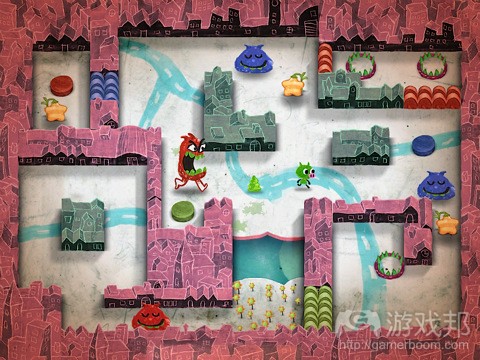阐述平板电脑游戏交互设计的基本规则
作者:Evan Shamoon
苹果于2008年推出App Store后,迅速成为游戏领域的舵手。游戏开发商也在突然间拥有了更广泛的开发平台,面向强大而具有大众市场的移动设备制作游戏。我们根据是一些最为成功的平板电脑游戏,总结出了相关交互设计基本规则:
规则1:挑战玩家——但是一定要适度
针对于广大平板电脑用户的游戏设计最基本原则,也许就是确保为玩家提供适度的挑战,达到或者接近他们的技能水平。《Trainyard》开发者Matt Rix表示:“一般来说,比起困难的游戏,简单点的游戏设计更加有吸引力。我们总是很容易向多数游戏添加一些玩家希望看到的难题和挑战,但如果玩家因为遇到难度而挫败时,我们便可能永远失去这些玩家。”
规则2:循序渐进地设置难度
Rix特别强调游戏开发者应该尽可能地向玩家呈现他们投入了百分百努力而创造出的优秀内容。他继续说道:“如果你很擅长玩《Trainyard》,那么你便能够快速完成这款游戏的简单关卡,并希望继续挑战更高层次的关卡。我认为游戏就必须采取这种循序渐进的方法。因为如果你让玩家感觉自己拥有技能但却只能玩一些简单的游戏,他们必将会为此沮丧不已。”
规则3:反馈,奖品和激励
以反馈或激励形式给予玩家奖赏也是游戏设计一核心要点,Rix自然也提到了这一点,他说道:“游戏必须让玩家知道自己该做些什么(以及为何要这么做),否则玩家将会对游戏感到迷惑。但是,同时你也不能立马给予玩家奖励,因为这会让奖励失去意义。而如果你能够在玩家完成一些实际任务后给予奖励,那么即使游戏未说明‘干得好!’这也同样会让玩家萌生出自豪感。”Rix补充道,如果可能的话,要把奖励变成是增强玩家成就感的工具而非单纯地创造这种成就感。
规则4:千万别忽视叙事元素
也有些游戏设计原则总是很容易被忽视。Revolutionary Concepts(游戏邦注:澳大利亚独立游戏工作室,旗下的《Gesundheit! HD》获得了巨大的成功)的创意总监Wayne Whatford表示:“我们在游戏设计中使用的一种规则便是叙事元素。即如果游戏中拥有主角或其他角色,那么他们分别是谁?在当前环境中他们是如何出现的?他们要如何解决面临的各种情境?最重要的是,如何让玩家关注这些角色?”
Whatford说很多开发者都容易轻视这种叙述性,认为它只是市场营销的附加物,投入于此只会浪费时间和精力。但是如何使用合理的话,便能够创造出强大的叙述体验,为游戏提供更加紧凑的上下文逻辑,并且更好地调动玩家情绪。“叙述性能够让玩家更加身临其境地感受游戏。不论是在舞台上,书本上,电影里还是现今的其它数字媒体中,这都是娱乐媒体几千年发展以来亘古不变的真理。可以说,这是创造一款优秀游戏设计的基础!”
以下则是来自Firemint创意总监Steve Fawkner(《战神的挑战》系列的创造者)所提出的交互设计过程中应该包含6大概念和原理:
1.任何一件新事物都不是直观的。我们必须通过反复循环与奖励帮助玩家熟知新事物。
2.确保玩家做出的每个选择都是有意义的。
3.每个玩家都希望成为英雄或众人关注的焦点。
4.为了让玩家更好地享受游戏设置的乐趣,不要强迫他们理解一些过于复杂的内容。
5.不要给予玩家一些没有意义的奖励。
6.循序渐进地呈现难度。玩家将会选择最适合自己的难度关卡进行挑战。
(本文为游戏邦/gamerboom.com编译,拒绝任何不保留版权的转载,如需转载请联系:游戏邦)
Tablet Games: 10 important new (old) rules of interactive design
by Evan Shamoon
Narrative plays a powerful role in Revolutionary Concepts’ award-winning Gesundheit
From Gesundheit to Trainyard, game designers are exploring and exploiting the boundaries of classic game design.
Few can say they saw it coming and not be lying, but when Apple launched its App Store in 2008, the company almost immediately became a major player in the gaming space. Game developers suddenly had a powerful, truly mass-market set of devices they were able to build content for, and that they did: From Angry Birds to Zookeeper and the tens of thousands of titles in between, games have been the most popular, profitable category on the App Store.
What’s more, across all categories, from mainstream board games to 8-bit versions of the all-popular shooter genre, the most successful tablet games are unearthing and re-contextualizing many classic and fundamental rules of interactive design.
Rule #1: Challenge the player—but not too much
Perhaps the most basic rule, particularly when designing for as wide audience as tablet owners, is to always ensure that players are presented with appropriate challenges, at or near the margins of their skill level. “In general, I think it’s better for your game to be too easy than too hard,” says Trainyard creator Matt Rix. “For most games, it’s easier to add difficulty and challenges for the players that want it, but once a player gets frustrated and stuck, you’ve probably lost them forever.”
Rule #2: Don’t let players not see your work
Rix’ point underscores a corollary to the challenge rule, which dictates that game developers want to make as much of their (hopefully) awesome, high-effort content as available to the player as possible. “If you’re good at Trainyard, the easy puzzles will go by very quickly, and you’ll be onto challenging puzzles in no time,” Rix goes on to say. “I think it’s important for games to scale in this sort of way. Nothing is more frustrating than a game where you know you’ve got the skills to finish an easy level, but it takes forever anyway.”
Rule #3: Feedback, rewards, and incentives
Rewarding the player with feedback and clear incentives is another core pillar of game design, and one not lost on Rix. “A player needs to know what they should be doing (and why), or they’ll quickly feel lost and confused,” says Rix. Still, there are limits: “If you reward players constantly, the rewards will quickly lose their meaning. It’s ideal if you can reward players for doing things that are actual accomplishments, things that they would have felt proud of even if your game hadn’t said, ‘Good job!’” When possible, Rix recommends using rewards to enhance the player’s existing sense of accomplishment, rather than manufacture it.
Rule #4: Don’t ignore the narrative
Of course, other rules of game design are perhaps more easily ignored. “A kind of rule that we employ internally is that of the use of narrative,” says Wayne Whatford, founder and creative director of Revolutionary Concepts, whose Konami-published game Gesundheit! HD has been a critical darling and commercial success. “If there is a main protagonist or character who is he/she/it? How do they come to be in their current environment, what do they need to do to resolve the situation in which they find themselves, and most importantly why should you as the player care?”
Whatford says that too many developers are dismissive of narrative as some sort of marketing addendum that creates extra work. Used properly, however, he says that building a strong narrative not only provides context, but can ideally achieve the lofty goal of stirring the player’s emotions. “They will experience some degree of empathy for your characters, and feel compelled to want to find out what happens. This is true to a greater or lesser degree of every entertainment medium for thousands of years, whether on the stage, in books, movies, or now digital media. It is fundamental to good game design.”
Evan Shamoon has covered the video game industry since 1998
6 fundamental concepts all tablet game designers need to embrace
We asked Steve Fawkner, creator of the Puzzle Quest series and Design Director at Firemint, to codify the concepts and philosophies that have helped guide his interactive design process.
Here’s what he told us.
1. Nothing new is ever intuitive. A cycle of repetition and rewards is how we teach players new things.
2. Every choice a player makes should feel meaningful to the player.
3. Every player wants to either feel heroic or be the center of attention.
4. Do not require the player to understand something complex in order to appreciate or enjoy an element of gameplay.
5. Never give the player a reward or a benefit that they don’t feel they earned.
6. Complexity is best displayed in layers – like an onion. Players will gravitate to the level of complexity they are comfortable with and stay there.(source:tabtimes)









































 闽公网安备35020302001549号
闽公网安备35020302001549号